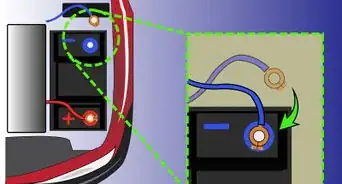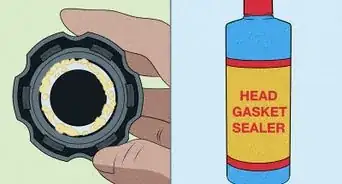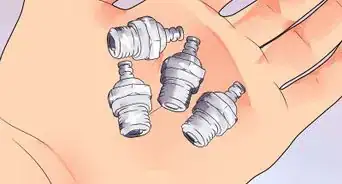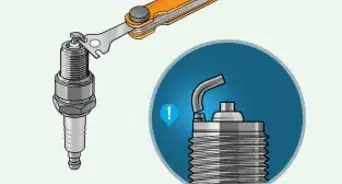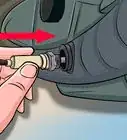This article was co-authored by Mike Parra. Mike Parra is a Master Mechanic in Arizona. With over 20 years of mechanic experience, he has experience working with American, European, and other foreign makes and models. He is ASE (Automotive Service Excellence) certified and has an AA degree in Automotive Repair Technology.
wikiHow marks an article as reader-approved once it receives enough positive feedback. In this case, 85% of readers who voted found the article helpful, earning it our reader-approved status.
This article has been viewed 447,743 times.
A spark plug wire is a basic but critical engine component. It carries the high voltage (30k to 50k volts) produced by the ignition coil to the spark plug. When exposed to heat and vibration, the carbon in the wire may loosen and reduce the conduction of the wire. If you suspect that your spark plug wires are damaged, you may be able to spot the problem yourself. Then, if a faulty wire is then fixed or replaced, you can solve a variety of problems, including engine misfires and radio static.[1]
Steps
Inspecting the Spark Plug Wires with the Engine Off
-
1Look for physical damage to the wires or boots, such as cuts and scorch marks. Use a flashlight or an area with good lighting to perform a visual inspection of the spark plug wires and the cap on top of them, called the boot. These will be a line of wires coming out of the cylinder head and attached at the other end to the distributor or ignition coils. Examine the insulation around the wires as they move away from the spark plugs. [2]
- Scorch marks signal damage due to high heat from the engine compartment.
-
2Check for corrosion between the boot and the spark plug and coil. Remove the boot from the top of the spark plug and look at the area where the connection was made. Make sure there is no discoloration or damage. Then remove the spark plug and inspect the the bottom of it for discoloration or damage.[3]Advertisement
-
3Inspect the spring clips that hold the wires in the distributor cap. Follow the wires away from the cylinder head to the other end, where they attach to the distributor. Wiggle the end of the wire, making sure that the clips are holding the top of the spark plug solidly. When undamaged, they create the pressure that keeps the wire and the plug connected solidly.[4]
- Damaged clips may allow the wires to slip and not hold their proper position.
Doing an Inspection with the Engine On
-
1Identify symptoms associated with a faulty spark plug wire. Defective spark plug wire leave tell-tale signs of their deterioration. The most common symptoms include:
- An erratic idle
- Engine misfire
- Radio interference
- Decreased fuel mileage
- Failed emissions tests due to elevated hydrocarbon emissions or a fault code indicating cylinder misfire
- Check engine light
-
2Do a visual inspection while the engine is running. Sometimes you will be able to identify a problem just by looking over the engine. Look for electrical arcs around the spark plug wires. Also listen for an abnormal snapping noise, which may indicate a high-voltage electrical leak.[5]
- Have someone else rev the engine while you continue to look at it. Look and listen for abnormal changes, such as arcs or smoke.
-
3Use a screwdriver to test the insulation of the wires. Get a piece of wire that is long enough to reach from a ground source to the spark plugs on your car. Tie one end to the shaft of a well-insulated screwdriver. Tie the other end of the wire to the ground source Then drag the screwdriver tip down the length of each spark plug wire, around the coil, and the boots. If you see an arc from a wire to the screwdriver, you have defective wire.[6]
- It is important to use a well-insulated screwdriver for this test. If you don't, you run the risk of shocking yourself.
-
4Spray down the spark plug wires to look for arcing. Fill a spray bottle with water and spray all along the wires. You will want to focus your spray near the boots that attach to the spark plugs to see if any arcing occurs there. If arcing is found at the boot near the spark plug, turn off the engine and inspect the boots further.[7]
-
5Inspect the inside of the boot for carbon tracking. Once you have sprayed the spark plug wires and there has been arching, you need to look at the inside of the boot. Remove the boot from the plug by pulling it straight up and off. Check inside the boot for carbon tracking, which is a residue that leaves black marks all over the inside of the boot. The buildup of this carbon shows that the connection is not optimal and can lead to misfiring.[8]
- If carbon tracking is present, the spark plug and the wire should be replaced.
Checking the Wires with a Meter or Diagram
-
1Locate the spark plug's resistance rating. This is typically listed in the vehicle's factory service manual. You can also search online for the service manual of your car if you don't have it on hand.[9]
- If you don't have your car's service manual, or you have after-market wires, you can usually find this information online. Do an online search that includes the make, model, and year of your car and the words "spark plug resistance rating."
-
2Use an ohm meter to check the resistance of the wires. This can determine if the resistance of the wire is in compliance with the recommendations. Remove the wire from the engine by pulling the boot off the spark plug and unscrewing the wire at the other end. Then place one probe on each end of the wire. Make sure they touch the metal contacts.[10]
- Use the meter to verify that the resistance is within the range called for in the car's manual.
-
3Determine if your spark plug wires are routed properly. Look at the spark plug diagram in the vehicle's manual to help you with this task. Trace each of the spark plug wires from its connection on the engine block to its corresponding spark plug. It is important that each wire goes to a specific spark plug.[11]
- This can be a problem if you have had your spark plugs changed and the boots get put back on in the wrong order.
- Cross coupling can create an energy drain, causing engine trouble.
Warnings
- If you have a pacemaker or a similar device you should not test spark plug wires yourself, as an accidental shock can interfere with its function. Instead, hire a mechanic to test them for you.⧼thumbs_response⧽
Things You'll Need
- Flashlight
- Jumper wire
- Screwdriver with insulated handle
- Ohm meter
References
- ↑ https://www.popularmechanics.com/cars/how-to/a82/1272351/
- ↑ https://www.popularmechanics.com/cars/how-to/a82/1272351/
- ↑ https://www.yourmechanic.com/article/how-to-check-spark-plug-wires-by-robert-tomashek
- ↑ https://www.yourmechanic.com/article/how-to-check-spark-plug-wires-by-robert-tomashek
- ↑ https://axleaddict.com/auto-repair/Checking-spark-plug-wires-using-two-simple-strategies
- ↑ https://axleaddict.com/auto-repair/Checking-spark-plug-wires-using-two-simple-strategies
- ↑ https://www.yourmechanic.com/article/how-to-check-spark-plug-wires-by-robert-tomashek
- ↑ http://www.zr1specialist.com/HAT%20Web/facts%20and%20failures/spark%20plug%20carbon%20track.htm
- ↑ https://axleaddict.com/auto-repair/Checking-spark-plug-wires-using-two-simple-strategies
About This Article
The easiest way to test your spark plug wires is by using an ohm meter to measure resistance. Look in the owner's manual to find the appropriate resistance for the wires. Then, pull the boot off of the spark plug and unscrew one of the wires at the end. Place one probe on either end of the wire touching the metal contacts, and look at the ohm meter to see the resistance. Make sure it matches the resistance in the manual. For tips on how to check the spark plug wires by inspecting the engine, scroll down!
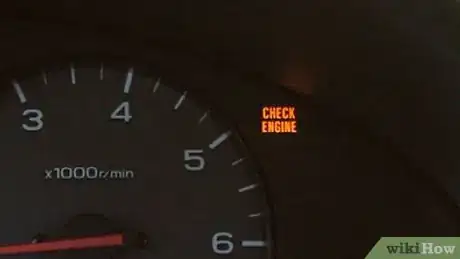
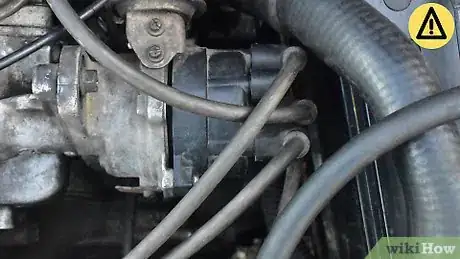
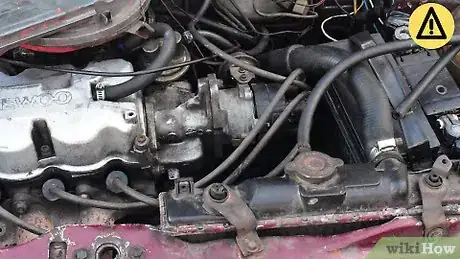
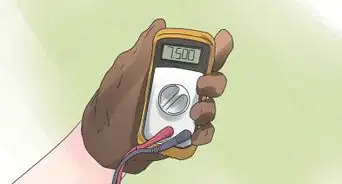



-Beetle-Step-5-Version-3.webp)


